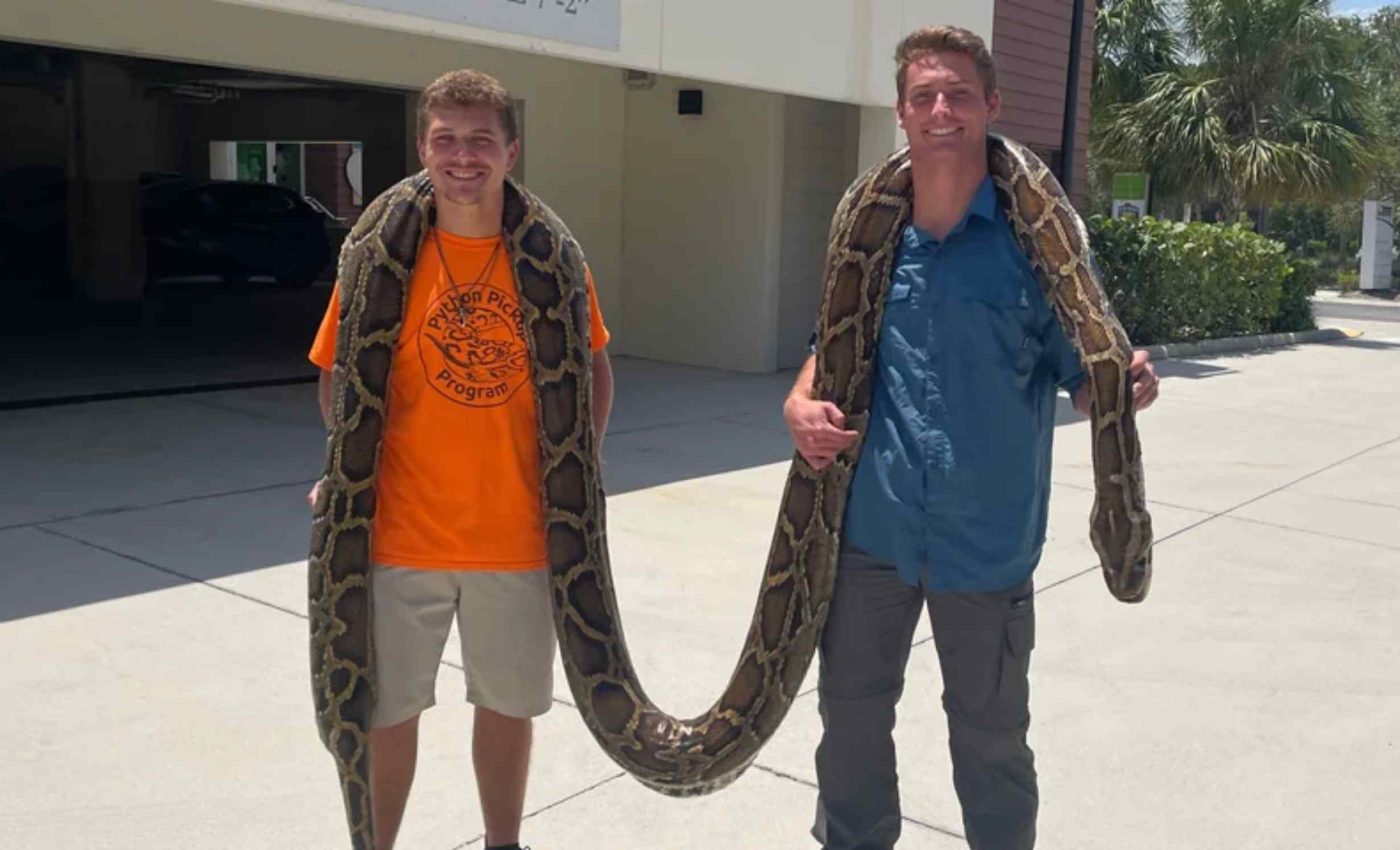
Burmese python as long as an adult giraffe is captured in Florida, setting a new record
A 19 foot Burmese python was captured in Big Cypress National Preserve in Florida, setting a new state length record. The capture was led by Jake Waleri near Naples on July 10, 2023.
Conservancy biologist Ian Easterling oversaw the official measurements and sampling for the specimen.
He and his team carefully recorded its length, mass, and genetic samples to contribute to long-term tracking of python population dynamics in South Florida.
“We had a feeling that these snakes get this big and now we have clear evidence,” said Ian Easterling, Conservancy of Southwest Florida.
The snake weighed 125 pounds, which helps researchers benchmark the growth potential of this species in South Florida. Measurements and samples also guide how teams target large breeding females during removal work.
“We brought the snake to the Conservancy to be officially measured and documented,” said Waleri. The team then turned over the animal so scientists could log data and preserve tissue for study.
The record is not only a number. It is a data point that helps refine field tactics, from how far teams search at night to where vehicle patrols focus after heavy summer rains.
Florida pythons are invasive predators
Burmese pythons are classified as an invasive species, as a nonnative animal that spreads and causes harm. Decades of field work have built an overview of how these snakes thrive in wetlands from Miami to the Gulf coast.
They function as an apex predator. Adults routinely consume mammals, birds, and reptiles, which puts intense pressure on native wildlife that did not evolve with giant constrictors.
The snakes tolerate water, heat, and long dry spells, so they exploit canals, swamps, and roadside ditches. Camouflage and sit and wait behavior make them very hard to spot in the sawgrass and cypress understory.
Egg production magnifies their impact over time. A single large female can seed a broad area with offspring that disperse through connected marsh and tree island networks.
How Florida responds to pythons
Florida encourages humane removal of these snakes by the public and by trained contractors under clear state guidance. No permit is required on private land with permission, and there is no bag limit.
Members of the public may not transport a live python and must use approved humane methods. The state outlines safe steps, from immediate dispatch to proper disposal and careful handling to reduce risks.
Free training programs teach identification, reporting, and safe capture skills to residents across South Florida.
Local partners also coordinate night surveys, road patrols, and rapid response when credible sightings are reported.
Removal is only part of the toolkit. Education, responsible pet ownership, and careful containment standards help close the door on new releases into the wild.
Learning from this Florida python
A record size animal offers a snapshot of maximum performance in a new environment. Researchers log length, mass, head measurements, and sex.
They look for measurable features like body size and shape that help test growth models for Florida conditions.
Tissue samples support genetic work to understand how many founders established the population and how it spreads.
Stable isotope and stomach content analyses can also reveal diet patterns and hunting ranges across seasons.
Reproduction data are especially valuable. Clutch sizes in Florida typically range from 22 to 84 eggs, with an average near 49.
Knowing where and when large females move during the breeding season lets managers concentrate effort when it matters most. Each documented big female removed can prevent thousands of hatchlings over a few years.
What this means for wildlife
Everglades mammal communities have collapsed in places where pythons are well established, as a 2012 study documented with sharp declines in raccoons, opossums, and other species.
The pattern matches the expansion of pythons across long patrol routes inside Everglades National Park.
Losses ripple outward through food webs. Fewer midsize mammals can change seed dispersal, nest predation, and even how often mesopredators compete with wading birds for shared prey.
Large snakes also consume birds, baby alligators, and other reptiles that anchor the region’s biodiversity. That is why prompt removal, paired with habitat protection, remains a core priority for conservation teams.
A record animal attracts attention that can translate into public participation. Awareness pushes more people to report sightings, learn safe practices, and support funding for control programs across the Everglades.
Staying safe and helping out
People should never approach or handle a large constrictor unless trained and properly equipped. Reporting sightings to local hotlines or partner groups speeds up response and keeps both residents and wildlife safer.
If a sighting occurs on private land, owners can authorize removal by trained personnel who follow state rules. Communities benefit when neighbors coordinate access and share accurate location details with teams in the field.
Sightings at night along levee roads or park edges deserve special caution. Drivers should pull off safely, keep distance from the snake, and call authorities rather than trying to restrain an animal that can strike with surprising speed.
Public science matters here. Simple steps like a photo with location data, a quick call, and waiting nearby at a safe distance can make the difference between another python slipping away and a removal that protects local wildlife.
Image credit: Conservancy of Southwest Florida.
—–
Like what you read? Subscribe to our newsletter for engaging articles, exclusive content, and the latest updates.
Check us out on EarthSnap, a free app brought to you by Eric Ralls and Earth.com.
—–













